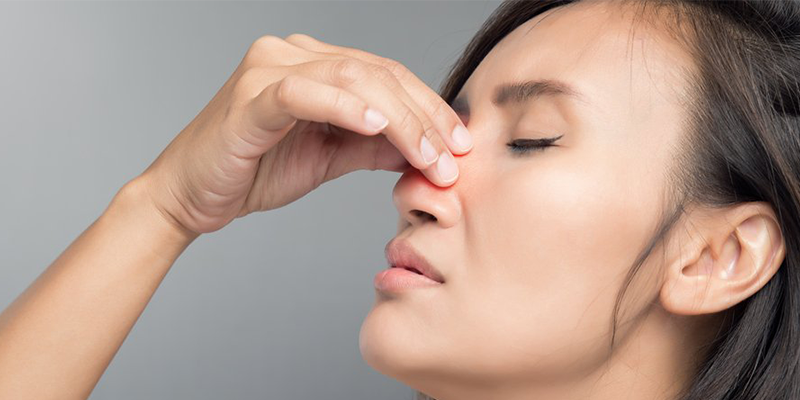Nasal Congestion, Healthy breathing starts with the nose. Nasal congestion can lead to a variety of diseases, from growth retardation to recurrent pharyngitis attacks. It can lead to conditions that go up to pulmonary heart disease in particular. We can basically collect the causes of nasal congestion under 4 main headings.
Structural factors
The most common cause in this class is SEPTUAL DEVIATION, i.e. the curvature of the structure composed of bone and cartilage in the middle of the nose, which divides the nose into two parts. This curvature can be congenital but can also be caused by a trauma. The nasal development is completed at about 18 years of age.
Even minor traumas that can be encountered up to this age can disrupt the nasal development. Septum deviation is the most common cause of nasal congestion in the community, and its definitive treatment is surgery.
One of the other structural causes is the NASAL CONCHAE, which increases the contact surface for the inhaled air in the nose, and becomes the cause of nasal congestion when it grows excessively (conchae hypertrophy). Concha hypertrophy can be more common especially in allergic patients.
Nasal congestion in concha hypertrophy is mostly seasonal and depends on the environment. It is often accompanied by runny nose with thin, watery discharge. Some local sprays are helpful in the treatment of concha hypertrophy, but the condition can also be treated surgically when necessary.
It is possible to perform the surgical procedure with radio waves called radiofrequency, under local anesthesia and polyclinic conditions.
Another important cause of nasal congestion in the pediatric age group is a tonsil-like tissue in the nasal region, which we call the ADENOID TISSUE. It begins to grow at a certain age and then disappears spontaneously by 13 years of age. If it causes severe nasal congestion, snoring and sleep apnea in the child, it should be surgically removed.
We can consider NOSE NEOPLASMS to be among the structural causes as well. With a detailed endoscopic examination, tumoral formations originating from the septum or the concha can be detected in the nose.
Although nose neoplasms are rare disorders, they should be taken into consideration in cases of certain complaints such as nasal congestion, foul-smelling discharge, unexplained nose-bleeding and headache.
NASAL POLYPS are benign soft swellings hanging from the sinuses into the nose, which can develop especially in patients with allergic rhinitis. Diagnosis can be made by direct observation during the nasal examination.
The sinus tomography to be taken will give information about where it developed and expanded, and they can sometimes grow too much that can be seen even when viewed from the outside. It is treated surgically.
A FOREIGN OBJECT IN THE NOSE is the reason that should come to mind first, especially in cases of unilateral foul-smelling nasal discharge in the pediatric age group. In suspicious cases, the examination should be done accordingly, and the treatment should also involve the removal of the foreign object.
Infection
It is a clinical picture that manifests itself as nasal congestion, itchy nose, and nasal discharge due to the contamination of the mucosa in the nose by viruses or bacteria. The discharge can be thin and watery, which we call seromucous, observed in viral diseases.
If the discharge turns yellow and gets darker, in means in most cases that the condition also involved a bacterial infection. Diagnosis can be made during a general ENT examination. In suspicious or resistant cases, culture can be taken or radiological examinations can be needed.
In the treatment, we can use local nasal sprays called nasal decongestants. If these drugs cannot eliminate nasal congestion and general complaints, the picture can be evaluated with a new examination, and then antibiotic treatment can be performed accordingly.
Allergic Rhinitis
Rhinitis is the inflammation of the membrane (mucosa) in the nose. Allergic rhinitis, on the other hand, is the excessive occurrence of this inflammatory condition due to certain factors (pollen, house dust, fungus). Allergy is a misguided reaction to foreign substances.
It is a genetic disease that manifests itself with nasal congestion, sneezing spells, nasal discharge, itchy nose and coughing spells. If these complaints are due to house dust, they are observed in all seasons, but especially in winter. It is seasonal if it is caused by pollens. It is diagnosed based on the patient’s complaints and examination results.
It cannot be necessarily detected with the test. Allergy tests provide guidance in treatment. The treatment is planned as a preventive treatment, drug therapy, vaccine treatment, or surgical treatment (as an adjuvant treatment). Prevention is of great importance, and if an allergen can be detected, it is necessary to abstain from that allergen.
A drug treatment involves the use of nasal sprays, cortisone sprays, oral tablets called antihistamine, and anti-allergen drugs in the form of preventive oral tablets. Vaccination treatment (immunotherapy) is the only permanent treatment of allergic rhinitis.
Vaccination is the direct administration of the allergen to the person, with intent to make the patient familiar with the allergen. Success can reach 90% in well-selected patients.
If there is a structural disorder in a patient with allergic rhinitis, the problem should be surgically corrected. In such cases, surgery is performed as an adjunct treatment.
Vasomotor Rhinit
Nasal congestion and watery nasal discharge due to the environmental conditions (air conditioner, tobacco smoke, bad smell, perfume..) are the symptoms of vasomotor rhinitis. Vasomotor rhinitis is the structural disorder of the nerves which ensures the physiology of the nose.
Such a disorder causes the nasal vessels to contract and expand untimely. We can also observe vasomotor rhinitis in cases of thyroid dysfunctions, stress, pregnancy and some drug use. Especially the use of nasal sprays called OTRIVINE, ILIADIN, BURNIL should be limited because they can be addictive due to the substances in their contents.
Their continuous use should be limited to a maximum of 5 days. Cortisone-containing nasal sprays and some symptomatic drugs can be used in the treatment of vasomotor rhinitis.

